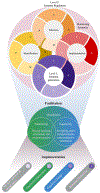Integrating mindfulness into the extended process model of emotion regulation: The dual-mode model of mindful emotion regulation
- PMID: 37843512
- PMCID: PMC11009092
- DOI: 10.1037/emo0001308
Integrating mindfulness into the extended process model of emotion regulation: The dual-mode model of mindful emotion regulation
Abstract
Extensive research has been conducted regarding how people manage their emotions. Within this research, there has been growing attention toward the role of mindfulness in emotion regulation. While prior reviews have discussed mindfulness in the context of emotion regulation, they have not provided a thorough integration using the prevailing models of emotion regulation or mindfulness. The present review discusses the Extended Process Model of Emotion Regulation and Monitoring and Acceptance Theory of mindfulness in order to propose a novel integrated framework, the Dual-mode Model of Mindful Emotion Regulation (D-MER). This model proposes two "modes" of mindfulness: Implementation and facilitation. Implementation posits that mindfulness skills can be used as emotion regulation strategies through attentional deployment and cognitive change. Facilitation posits that mindfulness as a state or trait affects emotion generation and regulation through effects on cognitive processes and positive or negative valence systems. Further, the D-MER posits that mindfulness experience can improve the efficiency of mindfulness-based emotion regulation strategies (implementation) while effects of mindfulness on emotion regulation processes become increasingly trait-like and automatic over time (facilitation). Empirical and theoretical support for this model are discussed, specific hypotheses to guide further research are provided, and clinical implications are presented. Use of this model may identify mechanisms underlying the interaction between mindfulness and emotion regulation which can be used in ongoing affective and clinical research. (PsycInfo Database Record (c) 2024 APA, all rights reserved).
Conflict of interest statement
The authors declare no conflicts of interest.
Figures



Similar articles
-
The mindful gaze: trait mindful people under an instructed emotion regulation goal selectively attend to positive stimuli.Cogn Emot. 2024 Mar;38(2):256-266. doi: 10.1080/02699931.2023.2270198. Epub 2024 Feb 6. Cogn Emot. 2024. PMID: 37987770 Free PMC article.
-
Socioaffective versus sociocognitive mental trainings differentially affect emotion regulation strategies.Emotion. 2019 Dec;19(8):1329-1342. doi: 10.1037/emo0000518. Epub 2018 Dec 27. Emotion. 2019. PMID: 30589299
-
Differential effects of state and trait mindfulness on the late positive potential.Emotion. 2018 Dec;18(8):1128-1141. doi: 10.1037/emo0000383. Epub 2017 Nov 27. Emotion. 2018. PMID: 29172619
-
Mindful Emotion Regulation: Exploring the Neurocognitive Mechanisms behind Mindfulness.Biomed Res Int. 2015;2015:670724. doi: 10.1155/2015/670724. Epub 2015 Jun 7. Biomed Res Int. 2015. PMID: 26137490 Free PMC article. Review.
-
Personality traits and emotion regulation: A targeted review and recommendations.Emotion. 2020 Feb;20(1):63-67. doi: 10.1037/emo0000644. Emotion. 2020. PMID: 31961180 Review.
Cited by
-
Implementation of Mindfulness-Based Emotion Regulation Strategies: A Systematic Review and Meta-analysis.Affect Sci. 2024 Oct 28;6(1):171-200. doi: 10.1007/s42761-024-00281-x. eCollection 2025 Mar. Affect Sci. 2024. PMID: 40094043 Review.
-
Day-to-day associations between mindfulness and perceived stress: insights from random intercept cross-lagged panel modeling.Front Psychol. 2024 Apr 16;15:1272720. doi: 10.3389/fpsyg.2024.1272720. eCollection 2024. Front Psychol. 2024. PMID: 38694436 Free PMC article.
-
Emotion Regulation as a Mechanism of Mindfulness in Individual Cognitive-Behavioral Therapy for Depression and Anxiety Disorders.Depress Anxiety. 2024 Apr 2;2024:9081139. doi: 10.1155/2024/9081139. eCollection 2024. Depress Anxiety. 2024. PMID: 40226724 Free PMC article.
-
Electroceutical enhancement of self-compassion training using transcutaneous vagus nerve stimulation: results from a preregistered fully factorial randomized controlled trial.Psychol Med. 2025 Aug 4;55:e223. doi: 10.1017/S0033291725101013. Psychol Med. 2025. PMID: 40755139 Free PMC article. Clinical Trial.
-
Mindfulness improves negative psychotic symptoms through reducing emotional and social withdrawal.World J Psychiatry. 2025 Apr 19;15(4):103362. doi: 10.5498/wjp.v15.i4.103362. eCollection 2025 Apr 19. World J Psychiatry. 2025. PMID: 40309602 Free PMC article. Clinical Trial.
References
-
- Aldao A, & Christensen K (2015). Linking the expanded process model of emotion regulation to psychopathology by focusing on behavioral outcomes of regulation. Psychological Inquiry, 26(1), 27–36. 10.1080/1047840X.2015.962399 - DOI
Publication types
MeSH terms
Grants and funding
LinkOut - more resources
Full Text Sources
Miscellaneous

